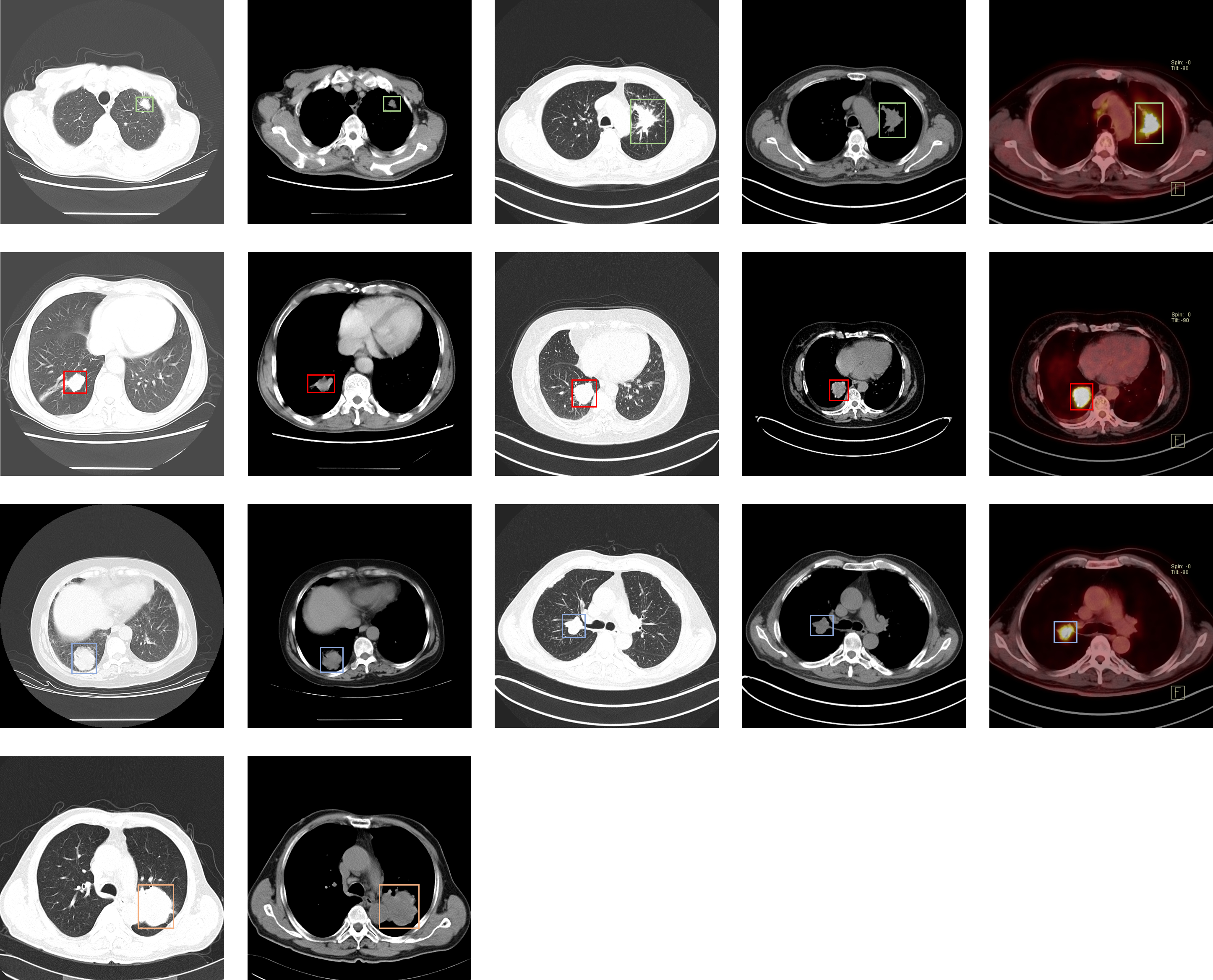Summary
This dataset consists of CT and PET-CT DICOM images of lung cancer subjects with XML Annotation files that indicate tumor location. The images were retrospectively acquired from patients with suspicion of lung cancer, and who underwent standard-of-care lung biopsy and PET/CT. The cases were confirmed by pathological diagnosis. The images were analyzed on the mediastinum (window width, 350 HU; level, 40 HU) and lung (window width, 1,400 HU; level, –700 HU) settings. The reconstructions were made in 2mm-slice-thick and lung settings. The CT slice interval varies from 0.625 mm to 5 mm. Scanning mode includes plain and contrast and 3D reconstruction. Before the examination, the patient underwent fasting for at least 6h, and the blood glucose of each patient was less than 11 mmol/L. Whole-body emission scans were acquired 60 minutes after the intravenous injection of 18F-FDG (4.44MBq/kg, 0.12mCi/kg), with patients in the supine position in the PET scanner. FDG Dose and uptake time were 168.72-468.79MBq(295.8±64.8MBq) and 27-171min (70.4±24.9 minutes), respectively.18F-FDG with a radiochemical purity 95% was provided. PET images were generated at one site using a similar protocol. Patients were allowed to breathe normally during PET and CT acquisitions. Attenuation correction of PET images was performed using CT data with the hybrid segmentation method. Attenuation corrections were performed using a CT protocol (180mAs,120kV,1.0pitch). Each study comprised one CT volume, one PET volume, and fused PET and CT images: the CT resolution was 512 × 512 pixels at 1mm × 1mm, the PET resolution was 200 × 200 pixels at 4.07mm × 4.07mm, with a slice thickness and an interslice distance of 1mm. Both volumes were reconstructed with the same number of slices. Three-dimensional (3D) emission and transmission scanning were acquired from the base of the skull to mid femur. The PET images were reconstructed via the TrueX TOF method with a slice thickness of 1mm. The location of each tumor was provided by five chest radiologists and two deep learning researchers in order to make this dataset a useful tool and resource for developing algorithms for medical diagnosis. The image annotations are saved as XML files in PASCAL VOC format, which can be parsed using the PASCAL Development Toolkit: https://pypi.org/project/pascal-voc-tools/. This section need a bit of a rewrite, which I'll work on (PAA): Five academic thoracic radiologists with expertise who are interested in lung cancer imaging annotated all subjects simultaneously using LableImg. Two radiologists of them are with more than 15 years of experience and the rest radiologists are with more than 5 years of experience. After labeling the respective subjects, these subjects will be passed to the other four radiologists for checking. Therefore, five radiologists have reviewed and checked all annotation files in the proposed dataset. Two deep learning researchers use the DICOM images and the corresponding annotation files to train several well-known detectors. In this way to test and verify whether the image data and annotations can be used directly by the Medical Imaging community. After training, we have got an acceptable mAP, around 0.87 on the validation set.
Acknowledgements
We would like to acknowledge the individuals and institutions that have provided data for this collection:
Drs. Huiping Han, Funing Yang and Rui Wang for their help collecting clinical data
The Computer Center and Cancer Institute at the Second Affiliated Hospital of Harbin Medical University in Harbin, Heilongjiang Province, China for their help collecting the image data
Beijing Municipal Administration of Hospital Clinical Medicine Development of Special Funding (ZYLX201511)
Data Access
| Data Type | Download all or Query/Filter |
|---|---|
| Images (DICOM, 128.6 GB) | (Download requires the NBIA Data Retriever) |
| Annotation Files (XML, 14.62 MB) |
Click the Versions tab for more info about data releases.
Please contact help@cancerimagingarchive.net with any questions regarding usage.
Detailed Description
Image Statistics | |
|---|---|
Modalities | CT,PT |
Number of Participants | 363 |
Number of Studies | 446 |
Number of Series | 1208 |
Number of Images | 21,3797 |
| Images Size (GB) | 128.6 |
Citations & Data Usage Policy
Add any special restrictions in here.
These collections are freely available to browse, download, and use for commercial, scientific and educational purposes as outlined in the Creative Commons Attribution 4.0 International License. Questions may be directed to help@cancerimagingarchive.net. Please be sure to acknowledge both this data set and TCIA in publications by including the following citations in your work:
Data Citation
Li, P., Wang, S., Li, T., Lu, J., HuangFu, Y., Wang, D. (2020). A Large-Scale CT and PET/CT Dataset for Lung Cancer Diagnosis [Data set]. The Cancer Imaging Archive. DOI: To Follow
TCIA Citation
Clark K, Vendt B, Smith K, Freymann J, Kirby J, Koppel P, Moore S, Phillips S, Maffitt D, Pringle M, Tarbox L, Prior F. The Cancer Imaging Archive (TCIA): Maintaining and Operating a Public Information Repository, Journal of Digital Imaging, Volume 26, Number 6, December, 2013, pp 1045-1057. DOI: 10.1007/s10278-013-9622-7
TCIA maintains a list of publications which leverage TCIA data. If you have a manuscript you'd like to add please contact the TCIA Helpdesk.
Version 1 (Current): 2020/05/dd
| Data Type | Download all or Query/Filter |
|---|---|
| Images (DICOM, 128.6 GB) | (Requires NBIA Data Retriever.) |
| Annotation Files (XML, 14.62 MB) |
Added new subjects.
